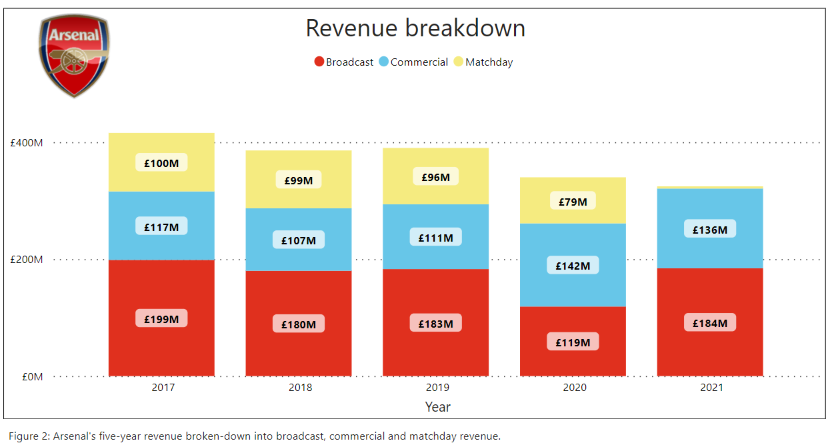Analysis of Arsenal's 2021 financial statements
The cost and benefit of sticking with Arteta and the impact of Covid-19
Arsenal is currently fourth-placed on the English Premier League (EPL) table and looking to return to the UEFA Champions League for the first time in five seasons. Despite below-par performances, the Arsenal board refrained from sacking Mikel Arteta in the 2019/2020 and 2020/2021 seasons, instead deciding to back him significantly in the transfer window. What is the cost of the board’s decision? How has Arsenal been able to cope in the first season without matchday revenue? Let’s dive in!
Revenue
At £328m in 2021, 5% down from 2020, Arsenal’s revenue is the lowest among the top-6 EPL clubs (see figure 1 below) and ranked eleventh globally. The fall in revenue is attributed to the impact of Covid-19, while the club’s ranking among its peers is because of consecutive eighth-place finishes in the EPL and absence from the UEFA Champions League (UCL).
Arsenal’s 2021 broadcast revenue grew by 55% from 2020. The club’s semi-final run in the UEFA Europa League (UEL) and deferred revenue for nine 2019/2020 games played in July- two months after the reporting period- due to Covid-19, are responsible for the revenue growth. The club’s commercial revenue decline of 4% in 2021 from 2020 is attributed to the impact of Covid-19, UCL absence and a comparatively modest commercial focus of the club, despite its London location.
Finally, Arsenal’s matchday revenue was £3.7m in 2021 because all but two games in the 2020/2021 season were played behind closed doors because of the Covid-19 pandemic.
Players: Transfers and profit and wage bill
Arsenal spent £115m in 2021 to acquire Thomas Partey, Gabriel, Pablo Mari and Alex Runarsson. In the same period, Emiliano Martinez was sold by Arsenal for £19m. In addition, Arsenal released Henrikh Mkhitaryan, Shkodran Mustafi, Sead Kolasinac, Sokratis Papastathopoulos, and Mesut Ozil on free transfers. As a result, Arsenal players’ sales profit of £12m is solely attributed to the sale of Emiliano Martinez.
Arsenal’s wage bill grew by £10m to £244m in 2021 from 2020 because of the net effect of the transfers mentioned above and the new contract signed by Club Captain Pierre Emerick Aubameyang. As a result, 75% of the club’s revenue was spent on its wage bill (see figure 5). The growth in the wage bill and percentage of revenue spent on wage bill could have been higher if the players did not agree to a 12.5% pay cut.
In the last article, I wrote about the rumours suggesting that UEFA is looking to revise its financial regulation by replacing the break-even requirement with a 75% threshold on both the wage bill and transfer amortisation. Together, wage bill and transfer amortisation are referred to as player expenses because the bulk of a club’s wage bill is related to its players, while transfer amortisation is the annual cost of the fees paid to buy players.
In 2021, Arsenal’s player expense to revenue was 111.50%, 36.5% above 75% in absolute terms. Assuming Arsenal’s fans were allowed into the stadium and matchday revenue for 2020 was the same for 2021, the percentage of player expenses to revenue would have been 91%, still above the rumoured threshold. Thus, Arsenal will need to take action to improve its position (see conclusion for possible strategies).
Finance cost and profitability
In 2021, Arsenal’s finance cost increased by £26m because of a one time £32.2m interest payment due to the early termination of the club’s stadium-related loans. The loans were tied to the club’s matchday revenue gate receipts, and because matches were played behind closed doors, the club needed to refinance the loans. The club’s owners replaced the £150m stadium-related interest-bearing loans by providing a £175m loan – which seems to be interest-free- to the club. Arsenal would be saving around £11m in interest payments annually.
Arsenal’s 2021 loss before tax was £127m, a £73m deterioration from 2020. The net effect of reduced revenue due to Covid-19, finance costs and the club’s transfer activity are responsible for the increased loss in 2021.
Conclusion
For a third consecutive year, Arsenal’s financial performance has deteriorated. Arsenal will need to increase its revenue – by qualifying for the UCL, finishing higher in the EPL table, earning more from players’ sales and improving its commercial focus – and/or reduce its costs – by streamlining its wage bill and scaling down its transfer activities- to improve its 2022 financial performance. In fourth place in the EPL, the last UCL qualifying spot, Arsenal is on course to significantly improve its 2022 revenue. In a football world where sticking with a seemingly underperforming coach is rare, it seems the decision to stick with Mikel Arteta was correct. Only time will tell.









